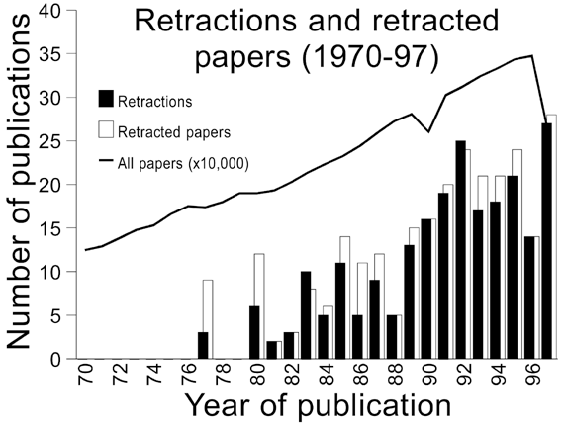January 1999
Retractions 1970-97
Massimo Battaglia and
Salvatore Lazzara
Institute of Experimental Medicine, Consiglio Nazionale delle Ricerche,
00133 Rome, Italy
In order to cope with the emerging problem of scientific misconduct and
fraudulent publication, an International Committee on Publication Ethics
has been set up by the editors of nine prestigious medical journals, and
the need for a British body for research misconduct has been
advocated1.
This prompted us to analyze the scientific literature records in the Medline
database for retractions
 in the period 1970-97.
A total of 266 papers (mean 9.50/year) were retracted in 229 retraction notices
(mean 8.17/year). No retractions, as shown in the accompanying figure, were
published until 1977, when 3 appeared, and in 20 years this figure increased
up to 27. This increase was, at least in part, paralleled by a corresponding
rise in the total number of publications. All the retractions and as many
as 261 (98.12%) of the retracted papers were published in English. More than
three fourths of the papers were retracted within 3 years, and about two
thirds within 2 years after publication.
in the period 1970-97.
A total of 266 papers (mean 9.50/year) were retracted in 229 retraction notices
(mean 8.17/year). No retractions, as shown in the accompanying figure, were
published until 1977, when 3 appeared, and in 20 years this figure increased
up to 27. This increase was, at least in part, paralleled by a corresponding
rise in the total number of publications. All the retractions and as many
as 261 (98.12%) of the retracted papers were published in English. More than
three fourths of the papers were retracted within 3 years, and about two
thirds within 2 years after publication.
These data raise several questions, and, among them: i) does this represent
a true increase in errors and fraud in the last 20 years? ii) is it
just the tip of the iceberg? iii) to what extent is pressure to publish
responsible for experimental error and manipulation of data? iv) how
should the journal editors and readers deal with error, fraud, retracted
papers, partial
retractions2 and even retracted
corrections3?
Our findings extend and complement the data recently reported by Budd et
al4, who searched cumulatively
the Medline database from 1966 through August 1997 for papers that had been
retracted, examined the reasons for retraction, and found that retracted
articles continued to be cited as reliable work after the publication of
retraction notice.
-
Smith R. The need for a national body for research misconduct.
BMJ 1998;316: 1686-1687.
-
Ichikawa T, Suzuki Y, Czaja I, Schommer C, Leßnick A, Schell J, Walden R. Identification and role of adenylyl cyclase in auxin signalling in higher plants.
Nature 1998; 396: 390.
-
Mandelboim O, Berke G, Fridkin M, Feldman M, Eisenstein M, Eisenbach L. CTL induction by a tumour-associated antigen octapeptide derived from a murine lung carcinoma.
Nature 1998; 392: 311.
-
Budd JM, Sievert ME, Schultz TR. Phenomena of retraction. Reasons for retraction and citations to the publications.
JAMA1998; 280: 296-297.
 in the period 1970-97.
A total of 266 papers (mean 9.50/year) were retracted in 229 retraction notices
(mean 8.17/year). No retractions, as shown in the accompanying figure, were
published until 1977, when 3 appeared, and in 20 years this figure increased
up to 27. This increase was, at least in part, paralleled by a corresponding
rise in the total number of publications. All the retractions and as many
as 261 (98.12%) of the retracted papers were published in English. More than
three fourths of the papers were retracted within 3 years, and about two
thirds within 2 years after publication.
in the period 1970-97.
A total of 266 papers (mean 9.50/year) were retracted in 229 retraction notices
(mean 8.17/year). No retractions, as shown in the accompanying figure, were
published until 1977, when 3 appeared, and in 20 years this figure increased
up to 27. This increase was, at least in part, paralleled by a corresponding
rise in the total number of publications. All the retractions and as many
as 261 (98.12%) of the retracted papers were published in English. More than
three fourths of the papers were retracted within 3 years, and about two
thirds within 2 years after publication.